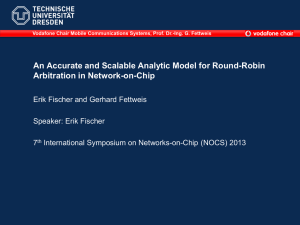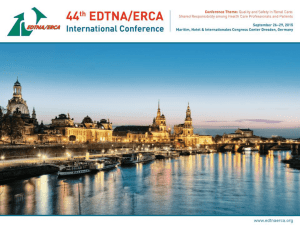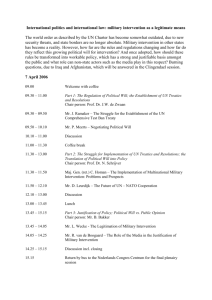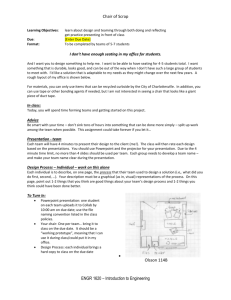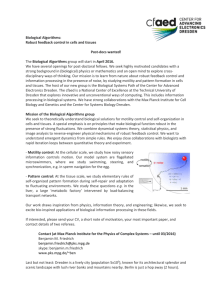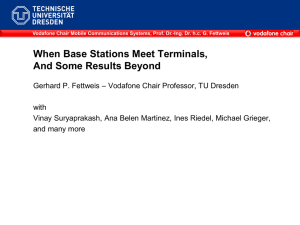Digital Modulation - Vodafone Chair Mobile Communications Systems
advertisement
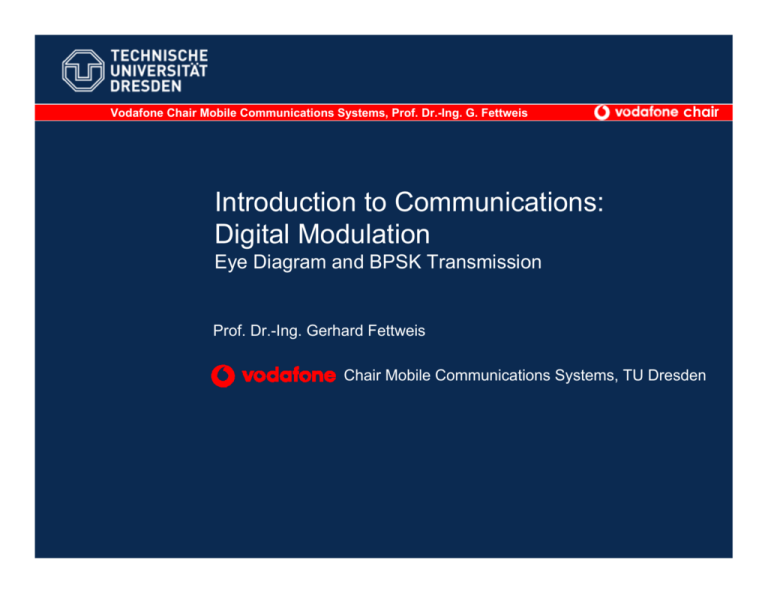
Vodafone Chair Mobile Communications Systems, Prof. Dr.-Ing. G. Fettweis chair Introduction to Communications: Digital Modulation Eye Diagram and BPSK Transmission Prof. Dr.-Ing. Gerhard Fettweis Chair Mobile Communications Systems, TU Dresden Digital Data Transmission (1) chair Transmit Filter Block diagram of the transmitter for transmitting digital data over a baseband channel Pulses of different symbols don’t overlap Ideal channel with infinite bandwidth (rectangular pulses!) can accommodate baseband transmission without signal distortion Error-free signal reconstruction possible TU Dresden, Gerhard Fettweis Slide 2 Digital Data Transmission (2) chair Transmit Filter Transmission over band-limited channel: Use a pulse shape with better localization in the frequency domain! Consequence: Each received pulse is affected by adjacent pulses. Inter-symbol interference (ISI)! ISI is a major source of bit errors at the receiver! Pulse shapes at transmitter and receiver have to be chosen carefully to minimize ISI (e. g. root-raised cosine pulses). TU Dresden, Gerhard Fettweis Slide 3 Visualization of Pulse Shape Properties chair Eye Diagram: Signal form viewed within one symbol interval Contributions from many overlapping pulses Horizontal and vertical aperture affects system performance Raised Cosine filter, r = 0.5 Raised Cosine filter, r = 1 1 0.8 1 Filtered signal Filtered signal 0.6 0.5 0 -0.5 0.4 0.2 0 -0.2 -0.4 -0.6 -1 -0.8 -1 1.5 1.6 1.7 1.8 1.9 2 2.1 2.2 2.3 2.4 2.5 time [s] TU Dresden, 1.5 1.6 1.7 1.8 1.9 2 2.1 2.2 2.3 2.4 2.5 time [s] Gerhard Fettweis Slide 4 chair BPSK Transmission over Noisy Channel BPSK Transmission over Noisy Channel TU Dresden, Gerhard Fettweis Slide 5 Baseband Transmission: System Model chair Transmit Filter Receive Filter Baseband equivalent transmission Transmitted signal has lowpass characteristics Channel is modelled as an AWGN channel TU Dresden, Gerhard Fettweis Slide 6 Eye Diagram: Noise Influence chair Eye pattern: α=1, noise free Eye pattern: α=1, SNR=12dB 1.5 1.5 1 1 0.5 0.5 0 0 -0.5 -0.5 -1 -1 -1.5 1.5 1.6 1.7 1.8 1.9 2 2.1 2.2 2.3 2.4 2.5 -1.5 1.5 1.6 1.7 1.8 time[s] 1.9 2 2.1 2.2 2.3 2.4 2.5 time[s] Presence of the noise causes closing of the eye. For low SNR, the eye is closed. Decision errors are made at the receiver. TU Dresden, Gerhard Fettweis Slide 7 BPSK Transmission: Noiseless Channel chair Eye pattern: α=1, noise free 1.5 1 0.5 0 -0.5 -1 -1.5 1.5 1.6 1.7 1.8 1.9 2 2.1 2.2 2.3 2.4 2.5 time[s] Grayscale picture of Barkhausenbau, TU Dresden Intensity of a pixel is encoded with n=8 bits Channel is noiseless and nondispersive: Error-free transmission TU Dresden, Gerhard Fettweis Slide 8 BPSK Transmission over AWGN Channel chair Eye pattern: α=1, SNR=4dB 1.5 1 0.5 0 -0.5 -1 -1.5 1.5 1.6 1.7 1.8 1.9 2 2.1 2.2 2.3 2.4 2.5 time[s] TU Dresden, Gerhard Fettweis Slide 9 BPSK Transmission over AWGN Channel chair Eye pattern: α=1, SNR=0dB 1.5 1 0.5 0 -0.5 -1 -1.5 1.5 1.6 1.7 1.8 1.9 2 2.1 2.2 2.3 2.4 2.5 time[s] Bad quality of the received picture TU Dresden, Gerhard Fettweis Slide 10 BPSK Transmission over AWGN Channel chair Eye pattern: α=1, SNR=-6dB 1.5 1 0.5 0 -0.5 -1 -1.5 1.5 1.6 1.7 1.8 1.9 2 2.1 2.2 2.3 2.4 2.5 time[s] Details are unrecognizable TU Dresden, Gerhard Fettweis Slide 11
